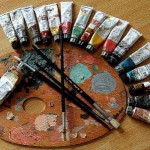Here is a list of oil painting materials…
you will need to get started. These products are available at many online retailers…or even better, if you are lucky enough to have an art supply store right in your town or area of the city, they will probably have everything you need or most will order anything they don’t have in stock.
OIL PAINTS – These come in a variety of colors, (or ‘pigments’); and vary in quality depending on their grade. Most companies offer different student & professional grade oil paints, assuming that beginners will be experimenting more and they alter their prices accordingly. For most colors you will only need the 37 ml tube, however; for White & Black, which you will use infinitely more than the others; they are available in 200 ml tubes. Another consideration is that certain oil pigments contain cadmium, lead, mercury, & cobalt; which can be absorbed through the skin, (or inhaled by those who mix their own paints using powder pigments). Many oil paints considered toxic, are now offered in a ‘hue’ form that does not contain volatile ingredients; & there are also newly fabricated’ water-soluble’ oil paints that clean up with soap and water.
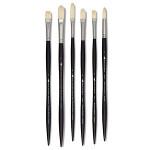 BRUSHES – There are many varieties of oil painting brushes which are differentiated by their type of bristles. They come in different sizes & shapes, as well as materials; to give you the option to create different textures & also for covering different sized areas of your painting. (See my post titled: Like a Pen to a Writer…a Knife to a Sculptor and also you can follow this link about Selecting the Correct Paintbrush.
BRUSHES – There are many varieties of oil painting brushes which are differentiated by their type of bristles. They come in different sizes & shapes, as well as materials; to give you the option to create different textures & also for covering different sized areas of your painting. (See my post titled: Like a Pen to a Writer…a Knife to a Sculptor and also you can follow this link about Selecting the Correct Paintbrush.
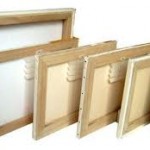 CANVAS – There are many different types of canvas to choose from. When you are just beginning, pre-stretched ‘cotton duck’ is less-expensive and you don’t need the more expensive linen type. Cotton duck usually comes pre-primed with gesso, so it saves you a step. After you’ve been painting for awhile, you will probably want to use linen that you stretch on canvas stretchers yourself, since it’s more cost-effective & gives you a greater flexibility of sizes. It’s also a better quality canvas that you should use if you want to sell your work.
CANVAS – There are many different types of canvas to choose from. When you are just beginning, pre-stretched ‘cotton duck’ is less-expensive and you don’t need the more expensive linen type. Cotton duck usually comes pre-primed with gesso, so it saves you a step. After you’ve been painting for awhile, you will probably want to use linen that you stretch on canvas stretchers yourself, since it’s more cost-effective & gives you a greater flexibility of sizes. It’s also a better quality canvas that you should use if you want to sell your work.
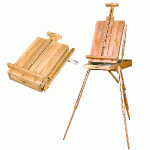 EASEL – An easel is a necessary thing for you to place your canvas on, while you are painting. Your canvas needs to be in a vertical vs. horizontal position, (I find around a 45 degree angle to be the most comfortable); in order for your painting to have the correct perspective. If you try to paint on a flat surface, you will not be happy with the results; since of course, a painting is meant to be viewed vertically & all the elements you would be painting would be affected by looking at it horizontally. Easels come in a variety of styles and materials, including wood, metal, table-top, ‘sketch-box’ or ‘French Easel’, ‘A-Frame’, etc. Choosing the appropriate easel depends on the size of the area you have to paint in & whether you are intending it for indoor or outdoor use, (landscape painters usually use the French Easel, since it is intended to be portable; & keeps most of your supplies inside).
EASEL – An easel is a necessary thing for you to place your canvas on, while you are painting. Your canvas needs to be in a vertical vs. horizontal position, (I find around a 45 degree angle to be the most comfortable); in order for your painting to have the correct perspective. If you try to paint on a flat surface, you will not be happy with the results; since of course, a painting is meant to be viewed vertically & all the elements you would be painting would be affected by looking at it horizontally. Easels come in a variety of styles and materials, including wood, metal, table-top, ‘sketch-box’ or ‘French Easel’, ‘A-Frame’, etc. Choosing the appropriate easel depends on the size of the area you have to paint in & whether you are intending it for indoor or outdoor use, (landscape painters usually use the French Easel, since it is intended to be portable; & keeps most of your supplies inside).
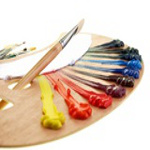 PALETTES – These are available in different types of surfaces, including: wood, metal, paper, & glass. A palette is the surface used for mixing paint & having different colors of pigment available during a painting session. You will need to choose one according to your preferences of ease of use, clean-up & durability.
PALETTES – These are available in different types of surfaces, including: wood, metal, paper, & glass. A palette is the surface used for mixing paint & having different colors of pigment available during a painting session. You will need to choose one according to your preferences of ease of use, clean-up & durability.
 PALETTE KNIFE – This tool is used both for mixing pigments, as well as apply them to your canvas for specific types of textures. I find that a thinner, more flexible ‘blade’ is easier to mix with; as well as to execute more of a range of textures in your painting.
PALETTE KNIFE – This tool is used both for mixing pigments, as well as apply them to your canvas for specific types of textures. I find that a thinner, more flexible ‘blade’ is easier to mix with; as well as to execute more of a range of textures in your painting.
 OIL PAINTING MEDIUMS – These come in several types and have different consistencies & uses. These vary in their properties of drying time, giving the artist more or less time to ‘work’ with them… (also called ‘working time’). Linseed Oil & Artist Painting Mediums, are a few of the types available; possessing different properties depending on what your needs are. I keep a few different ones on hand, so I have the option if time is a consideration. When you are 1st starting out, you should use one that has the longest working time; since you’ll need that while you are learning to work with paints and mediums.
OIL PAINTING MEDIUMS – These come in several types and have different consistencies & uses. These vary in their properties of drying time, giving the artist more or less time to ‘work’ with them… (also called ‘working time’). Linseed Oil & Artist Painting Mediums, are a few of the types available; possessing different properties depending on what your needs are. I keep a few different ones on hand, so I have the option if time is a consideration. When you are 1st starting out, you should use one that has the longest working time; since you’ll need that while you are learning to work with paints and mediums.
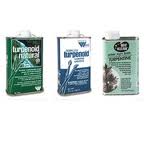 TURPENTINE – Turpentine is a solvent that is also used to thin paint, to make it easier to apply; as well as what is needed to clean your brushes. You have to be very careful when using turpentine, however; since it is absorbed through the skin, and proper ventilation is necessary to avoid inhaling harmful vapors. It should only be handled by persons old enough to understand the risks. Mineral Spirits are absorbed to a lesser degree, in fact they say it is not absorbed through healthy skin; but you still need to be careful using them. I use a product called ‘Turpenoid’, which is odorless; however, this doesn’t mean you shouldn’t use it in a well-ventilated area. It is suggested that hardware or industrial grade NOT be used, since it contains impurities that are removed in artist-grade turpentine or mineral spirits.
TURPENTINE – Turpentine is a solvent that is also used to thin paint, to make it easier to apply; as well as what is needed to clean your brushes. You have to be very careful when using turpentine, however; since it is absorbed through the skin, and proper ventilation is necessary to avoid inhaling harmful vapors. It should only be handled by persons old enough to understand the risks. Mineral Spirits are absorbed to a lesser degree, in fact they say it is not absorbed through healthy skin; but you still need to be careful using them. I use a product called ‘Turpenoid’, which is odorless; however, this doesn’t mean you shouldn’t use it in a well-ventilated area. It is suggested that hardware or industrial grade NOT be used, since it contains impurities that are removed in artist-grade turpentine or mineral spirits.
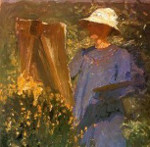 CLOTHING – You’ll want to wear comfortable clothes that you don’t care whether you will get paint and other substances like painting medium on. I usually wear an over-sized shirt over my clothes, that I can wear numerous times; and a pair of old jeans or shorts.
CLOTHING – You’ll want to wear comfortable clothes that you don’t care whether you will get paint and other substances like painting medium on. I usually wear an over-sized shirt over my clothes, that I can wear numerous times; and a pair of old jeans or shorts.


